
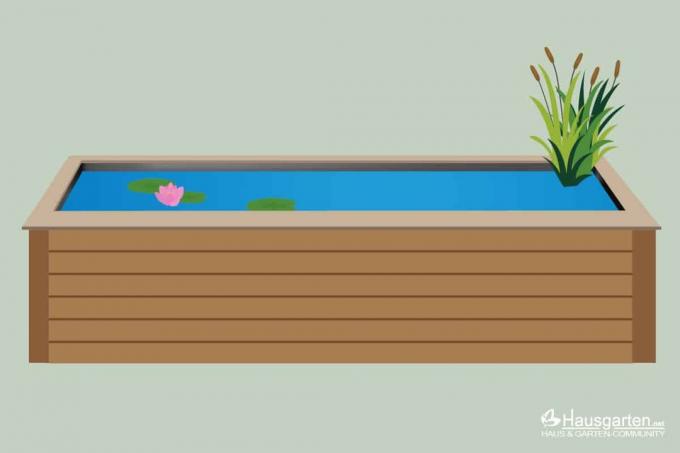
Table of contents
- material and border
- Size
- stable ecosystem
- high pond depth
- pond pump
- Location
- underground
- tightness
- pond liner
- planting
- water quality
- let the water rest
- plant choice
- Water filtering plants
- stones for earth surface
If you have decided on a raised pond, you will find numerous tips below so that it works with clean water, great planting and impressive fish keeping.
material and border
One of the most important criteria for self-construction is the selection of the material or the border. (Whiskey) barrels or other wooden materials are often used. However, it should be noted that wood is not weatherproof and can stretch/deform. Without special impregnation and regular care, wood as a high pond material does not remain dimensionally stable in the long term. If you want to save a lot of work in the long term, choose galvanized aluminum.
Size
Many people first build the pond and then think about which fish and plants they should definitely put in. This can have fatal consequences, because the size of the high pond must be adjusted so that the oxygen content in the water works and neither fish die nor a mud bath occurs. Therefore, always adjust the pond size based on the desired planting and fish stock. Of course, the available space at the location also plays a role. If this does not provide more than for setting up a small high pond, less fish and plants are possible.
stable ecosystem
Raised ponds are generally not to be regarded as a natural biotope with a high ecological value. Still, it can become one and remain stable if enough water fits inside. A stable ecosystem can be achieved from 100 liters.
high pond depth
If fish are placed in a pond, whether as a finished product, in the ground or as an above-ground specimen, the depth should be at least 80 centimeters. The depth means the height of the water. This is the only way to ensure that there is sufficient oxygen and freedom of movement for the fish. However, it depends on the respective fish species.
pond pump
If it is a mini high pond, a pump is usually not required if the water depth does not exceed one meter and the water volume does not exceed 300 liters. However, it makes sense in any case if the following factors apply:
- Lots of small fish that cause a lot of dirt and adversely affect the water quality
- To reduce algae formation when high ponds get a lot of sun
- For overwintering to avoid complete freezing, especially when high ponds face north and/or are in the shade
- Ponds with a water volume of 500 liters or more and fish always need a circulation pump for oxygen enrichment
Location
The best and fanciest raised pond will bring little joy in the long term if it is set up in a suboptimal location. With the following tips on the ideal location, problems can be avoided intelligently:
- Light: Five/six hours of sunlight are ideal to prevent algae growth and the spread of pathogens
- Away from deciduous trees because leaf debris acts like fertilizer on the water
- Secure location so that neither your own children nor the children of the neighbors get to it unnoticed
- If necessary, easily accessible power source if electrical equipment for cleaning, filtering or circulation is to be connected
underground
In order to achieve a balanced, even water pressure in the standing pond, it is important to ensure that the subsurface is level. As soon as this shows only minimal bumps, the waterline changes. This leads to higher water pressure in one or the other location(s). As a result, the weight shifts, which in the worst case makes it possible to tip over. Slight unevenness can be leveled out with play or construction sand.
tightness
When building and setting up a high pond yourself, the following tips can be used to achieve long-term waterproofing:
- Use pond liner primarily with wood material, as wood "works", which means it can warp and become leaky
- Before installation, be sure to clear the floor of stones and root remains
- Fleece on the subsoil prevents displacement by weeds and/or roots lying deep in the ground
- If necessary, work a close-meshed grid into the soil to prevent soil animals from eating through (e.g. voles)
pond liner

Pond liners are offered in a wide variety of thicknesses and qualities. Anyone who chooses cheap here often pays for this with multiple purchases and more work due to the need for rapid replacement. A pond liner is constantly exposed to water pressure, planting, fish and temperatures. In order to maximize the longevity of a pond liner, the following properties should be considered when purchasing:
- Weather and UV resistance as well as frost resistance
- Thickness of at least 0.5 millimeters
- Material: pollution-free polyethylene
- High-quality workmanship and quality
planting
Without plants, a pond not only looks half-finished and boring, but the water quality also suffers. If you want to build your own high pond and plant it with plants, you should therefore heed the following tips:
create floors
In order to prevent the plants from slipping and to increase the water purification power of plants, it is important to create tiers. The floors are set at certain heights like steps:
- First floor: Swamp zone up to a maximum of 20 centimeters water level
- Second floor: Shallow water zone between 20 and 50 centimeters water level
- Third floor: the bottom as a deep water zone from 60 centimeters
- In the case of shallower high ponds, the shallow water zone is the floor – the third floor is omitted
- A fourth tier is not required for high ponds with a water depth of more than 120 m
water quality
Simply hang in the water hose and fill the Hochteich - this is the most common way of filling a pond with water. Later, however, many wonder why plants do not take hold, develop poorly or even die. This can be due to the tap water if it is calcareous. Many plants do not tolerate lime. Therefore: it is better to use rainwater for filling. This also saves the effort for subsequent descaling.
let the water rest
When constructing raised ponds, the pond water should be allowed to rest after completion - especially if planting with oxygen plants is planned. The "fresh" water still has few microorganisms and the CO2 content is correspondingly low. As a result, the new aquatic plants have difficulty starting and/or growing. A rest period of four weeks is ideal. If immediate planting is desired, the water should be prepared with so-called CO2 tabs. These are available on the Internet, in well-stocked hardware stores and garden centers.
plant choice
The choice of plants should be done carefully and well planned if you create them yourself. There are numerous aquatic plants, but not all of them like standing in low or high water to the same extent. Also, some need more sun than others. It is also important to note whether the specimens are hardy or sensitive to cold. The following are a few examples of aquatic plants with different requirements and properties:
water lettuce(Pistia stratiodes)
- Growth: rosette-like, free-swimming
- Growth width: 20 to 30 centimeters
- Growth height: ten to 15 centimeters
- Flowers: white, from June to July
- Location: sun
- Hardy: no
- Suitable for small and large raised ponds, swamp zone
water lily 'Hermione'(Nymphaea x cultorum 'Hermione')
- Growth: rhizomes, fast-growing
- Growth width: 100 to 150 centimeters
- Growth height: five to 15 centimeters
- Flowers: white, from May to July
- Location: sun
- Hardy: up to 23.4 degrees Celsius (hardiness zone 6)
- For medium-sized to large high ponds in deep water zones
Dwarf Cattails(Typha minima)
- Growth: tightly upright, forming runners
- Growth width: 30 to 40 centimeters
- Growth height: 40 to 60 centimeters
- Flowers: simple, brown, from June to July
- Location: sun
- Hardy: up to 23.4 degrees Celsius (hardiness zone 6)
- Ideal for small and large high ponds, location at a water depth of 20 centimeters (swamp zone)

Water filtering plants
The following are some examples of planting with specimens that rank among the best water-filtering oxygen plants:
- water buttercup (Ranunculus aquatilis) – highest filter power in spring and winter
- horn leaf (Ceratophyllum demersum) – highest filter power in summer and autumn
- pondweed (Potamogeton natans) – highest filter power from spring to late summer
- waterweed (Elodea) – highest filter power from summer to late autumn
- fir fronds (Hippuris vulgaris) – highest filter power from spring to late summer
Tip:
Since not every "filter plant" releases oxygen all year round and therefore does not counteract the formation of algae, it is advisable to look for variety and different variations in aquatic plant species regard.
stones for earth surface
Unnecessary soiling is to be prevented by placing stones on the surface of the plant baskets after planting. These hold the soil down so it doesn't wash out and fish stir it up. It is important that the stones are rounded with no sharp segments so that they do not damage the foil if they fall out.
 garden editorial
garden editorial I write about everything that interests me in my garden.
Learn more about creating a pond

Build a duck coop yourself 7 tips for a duck house
Building a duck coop yourself is essential if you want to keep ducks yourself. But a protective shelter is also a practical and valuable aid for wild ducks. With our tips for building a duck house yourself, it's easy.
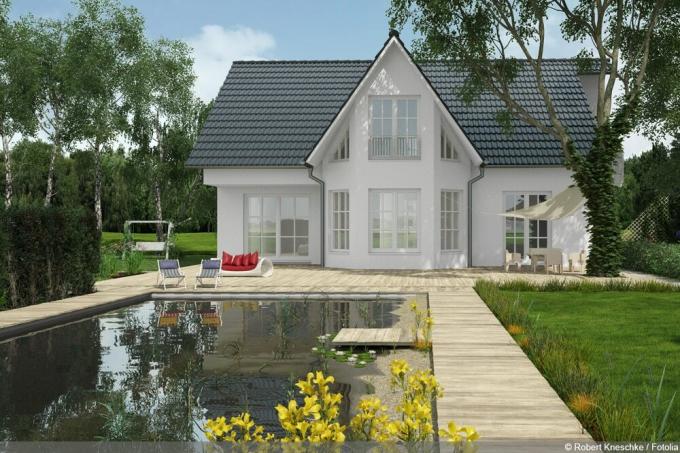
Make a swimming pond out of a garden pond: rebuild in 8 steps
Gardeners with manual skills transform the pond into a natural swimming paradise for the whole family. Thanks to the living sewage treatment plant, the private water world works in an exemplary manner without chemicals. This guide explains how to convert your garden pond into a swimming pond in 8 steps.
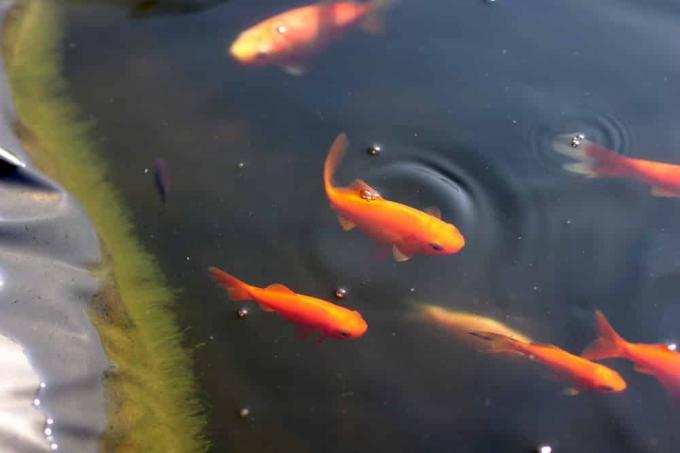
Fasten the edge of the pond: this is how the pond liner gets hold on the pond bank
Filled with water, maybe a few fish in it and attractively planted, a pond is a small piece of paradise in your garden. In order for this to remain so for a long time, the correct attachment of the edge and the pond liner is crucial.
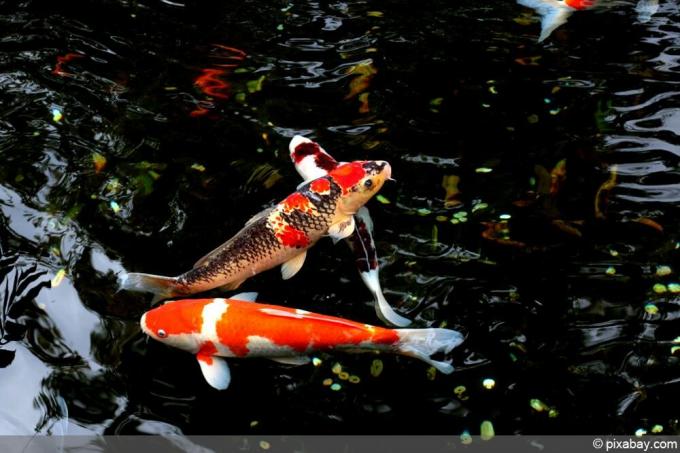
Creating a koi pond: requirements for size and filter system + costs
Kois are not only particularly noble, but also very demanding fish. Because the animals have certain requirements for their habitat, which must be taken into account when creating the koi pond.
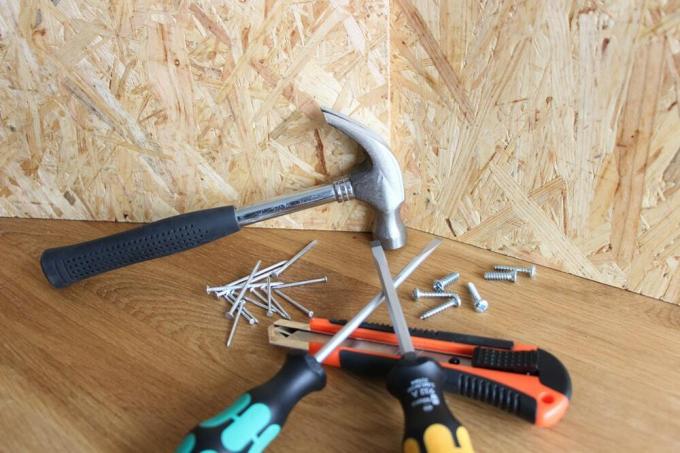
Build your own indoor pond – instructions in 10 steps
There are big differences in indoor ponds. A lot is possible, starting with plastic shells, such as those used in the garden, through brick and tiled ponds similar to a bathtub, to liner ponds in a wooden frame. Anyone who has never dealt with indoor ponds will be amazed at what some people come up with. Of course, the vessels can also be used for rooms, which are referred to as mini ponds or balcony ponds.

DIY stone foil – Instructions for making and laying yourself
Stone liner is mainly used for the edge design of liner ponds. It creates a natural transition from the pond to the garden. However, it is also well suited for streams or waterfalls. Stone foil is simply a foil that has been covered with small stones, mostly gravel. According to the manufacturers, purchased stone foil is robust and durable. The stones are fixed in such a way that they do not fall off even during longer periods of frost. In addition, a special seal ensures that the films are compatible with plants and fish.



